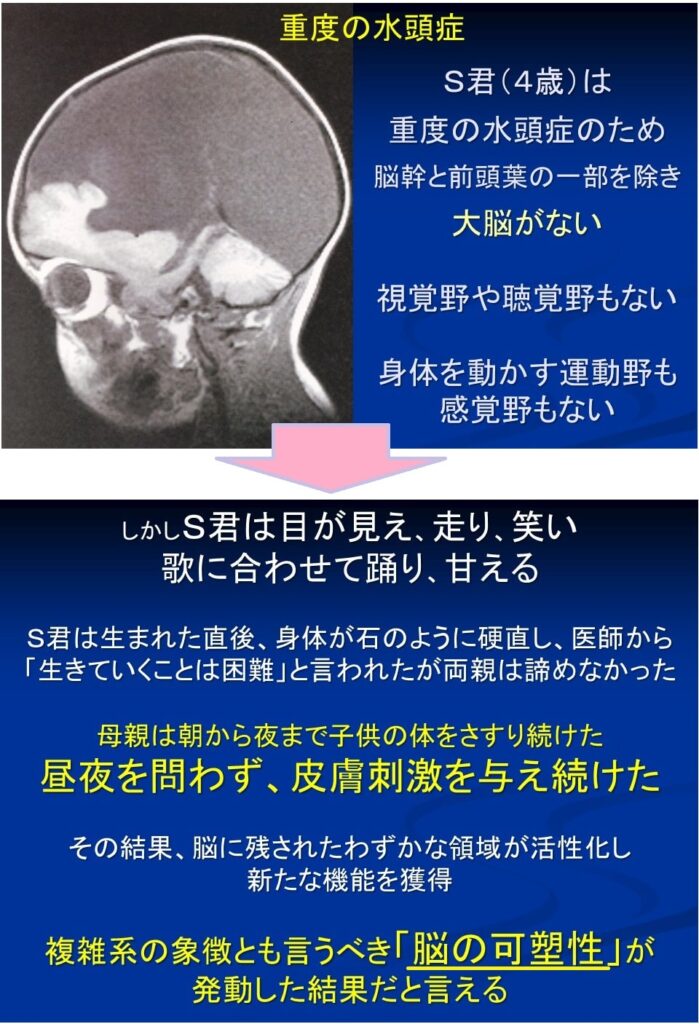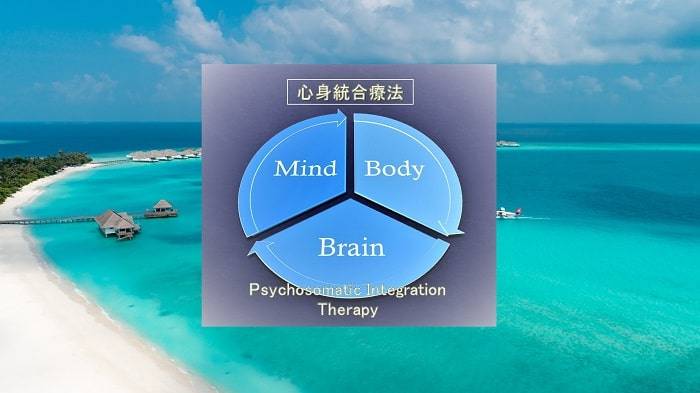
ヒトの脳が新たな能力を獲得するとき、あるいは損傷した脳が回復するとき、神経回路を強化したり、再配線したりすることで、脳は構造的にも機能的にも変化します。
このように脳がポジティブに変わっていく現象を神経可塑性または脳可塑性と言います。これは生涯を通じて発揮され、なかでも0~9歳の感受性期と呼ばれる時期は極めて高活性です。
一般の方にとって、神経可塑性はあまり馴染みがない用語かもしれませんが、私たちの脳に秘められたダイナミズムのひとつであり、同存在を物語る貴重な症例があります。それが下のスライド(当会の一般講演会で使用)です。

当会がタッチケアやタッチングといった触覚刺激を重視する理由は、上記スライドに象徴される脳膚相関(脳と皮膚の密接な関係性)というベース理念があるからです。ハグやソフトなマッサージ(強刺激はNG)に隠された真の効果はまさしく脳膚相関にあります。
神経可塑性は世界規模で研究されており、同臨床の最前線を紹介した名著「脳はいかに治癒をもたらすか(紀伊国屋書店)」において実例の数々が語られています。慢性痛やパーキンソン病、そして視覚障害から多発性硬化症に至るまで、難病と言われる数々の疾患が神経可塑性の発現によって劇的な回復を示すことが報告されています。
著者のノーマン・ドイジ氏はこうした回復に至るメカニズムについて
❶神経刺激 ❷神経調整 ❸神経リラクセーション ❹神経差異化と学習
❶は引き込み(エントレインメント)、❷❸は脳恒常性機能不全(BD)の回復、❹が神経可塑性の発現に当たると、当会は考えています。
リズミカルな刺激入力に脳が引き込まれて共振する現象。たとえばパーキンソン歩行がメトロノームの音によって劇的に改善したり、同リズム音が様々な運動を省エネ化したりする(NHK「ガッテン」で紹介)。
また当会が推奨するBReINにおけるタッチケアやタッチング系の技術は、1/fゆらぎ成分を含む振動が重視されており、引き込み効果が包含される。当然ながらオキシトシン効果も含まれる。
可塑性という言葉の起源は古代ギリシャ語 plastikos(成形できる)にあります。これを土台にして「熱や圧力で成形できる合成樹脂」を表すプラスチック(plastic)という用語が生まれ、材料力学においては「変形したまま元に戻らない性質」を塑性(plasticity)と言います。塑性と可塑性は同義です。
他方、同力学において物体に圧力を加えていった際「変形が元に戻る性質」は弾性(elasticity)と呼ばれます。弾性と塑性の違いは下図に示す通り、弾性は回復力を意味しており、塑性は変化する力を表しています。

日本の建築工学では制震技術のひとつに
ノーマン・ドイジ氏による治療の4段階モデルが示している通り、神経可塑性を発現させるためには、その準備段階として、脳を癒す作業が必須です。脳が疲れ切った状態では神経可塑性の発現すなわち神経回路のアップデートはうまくいきません。
したがって、脳に働きかけるアプローチを説明するとき、より正確な表現としては「疲れた脳を癒し、その上で神経回路の再配線を促す」ということになります。ところが、可塑性という概念には脳の癒し効果が含まれていない…。
つまり神経可塑性という用語には「脳を癒すプロセス」が含意されていないのです。
脳を癒すプロセス(脳恒常性機能不全(BD)の解消)は、いわば原状回復を意味しており、本来の姿に戻すこと、すなわち弾性という言葉で表すことができます。
であれば、可塑性ではなく、弾塑性という言葉に替えたほうが一言でその全てを表すことができます…。
とは言え、世界の潮流として、とくに欧米の医学論文では脳をポジティブに変える現象は可塑性(plasticity)あるいは可鍛性(malleability)が用いられています。
弾塑性という概念は、地震大国の日本が誇る制震技術の世界において最も認知されている用語であり、海外での認知度は低いかもしれませんが、当会にあっては脳弾塑性を誘導することで、様々な心身の不調や疾患が改善され得るのだということを、世界にアピールしていきたいと考えています。
心理学では、逆境から這い上がる力(回復力)を
当会が掲げる脳弾塑性には、脳のレジリエンスを高めることで、心と肉体と人生の総合的な健全性すなわちウェルビーングを向上させることが含意されているのです。
認知科学統合アプローチ(COSIA)に興味のある方へ
画像ラベリングと痛みの原因診断が乖離する現状において、世界疼痛学会(IASP)は痛みの定義を改訂し、「痛みの感情起源説」にシフトしています。
COSIAに興味のある方は是非一度「医療者・セラピスト専用サイト」にお越しください。貴殿のご参画をお待ちしております。



